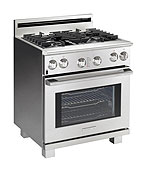
FRIDAY, Feb. 19 (HealthDay News) — Slaving over a hot stove — make that a hot gas stove — might raise your risk for certain types of cancer.
Researchers in Norway have found that cooking with gas produces more potentially harmful fumes than electric cooking.
But, in a report published online Feb. 17 in Occupational and Environmental Medicine, they also point out that professional chefs and cooks are more at risk than the average at-home cook.
“The risk to average at-home cookers is low, at least under Norwegian conditions, where most homes have a kitchen exhaust fan,” said study author Ann Kristin Sjaastad, who’s with the industrial economics and technology management department in the division of health environment and safety at the Norwegian University of Science and Technology in Trondheim. “Yes, professional chefs/cooks are most at risk, but further studies are necessary to estimate their risk level.”
The International Agency for Research on Cancer has classified cooking fumes from frying at high temperatures as “probably carcinogenic.” The fumes have been found to contain polycyclic aromatic hydrocarbons (PAHs), heterocyclic amines, higher and mutated aldehydes, and fine and ultrafine particles.
But a remaining question has been what role, if any, does the energy source — gas or electric– or type of fat used in frying play in producing the fumes.
The researchers created a kitchen typical of those in Western European restaurants, measuring 19 square meters (62 feet) and containing both a gas stove and an electric stove with a canopy hood.
They fried 17 pieces of beefsteak, each weighing about a pound, in both margarine and soya bean oil for 15 minutes. The only PAH found was napthalene (now banned, but once found in mothballs), most notably when frying with margarine on a gas stove, according to the report.
The highest levels of all compounds, including ultrafine particles that more easily penetrate the lungs, were produced while frying with gas.
However, even the higher levels of particles found in the study were below accepted occupational safety thresholds. But the researchers noted that cooking fumes contain various other harmful components for which there is as yet no clear safety threshold and that gas cooking seems to increase exposure to these components.
Regardless of the level of risk, cooks should follow certain “safe cooking” guidelines, said Dr. Lisa Ganjhu, an attending physician in the division of gastroenterology and liver diseases at St. Luke’s-Roosevelt Hospital in New York City.
That means don’t barbeque or char meat, don’t overheat the oil because that increases the level of toxins in the food, do use a drip pan so that grilling fat doesn’t touch the fire, make sure the exhaust fan is on and microwave meat before it’s grilled.
“In their homes, people can make sure that they have a powerful exhaust fan, preferably one that is vented directly to the outside and does not have a charcoal filter, Sjaastad emphasized. “Also, the fan must be run on the highest level of capacity to be efficient. Suction is improved if the fan is placed between two walls, between two cupboards or up to a corner. It is also very important to let the fan run for 15 minutes after you’re done cooking. In addition, people may reduce the amount of pan frying, for instance, by frying their steak shortly in the pan at first, and then bake it in the oven until it is finished.”
More information
The U.S. Agency for Toxic Substances and Disease Registry has more on PAHs.

